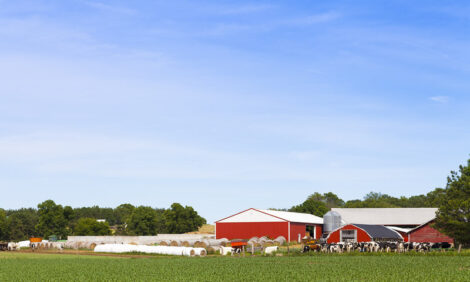



Calf Registrations Indicate Beef and Dairy Outlook For Britain and Ireland
ANALYSIS – The full effects of last winter and the delayed spring are now becoming apparent as levy boards report a five per cent drop in calf registrations across Great Britain.Lower fertility rates, fodder shortages and onfarm mortality have caused a contraction in the beef and dairy herds and tight supply forecasts for beef, analysts say.
Levy board and government data calculate calf registrations at 1.5 million head for the first six months of the year. This is the lowest position since 2009.
This has left non-dairy calves seven per cent down on last year and forced a two per cent drop in dairy calf registrations.
An EBLEX spokesperson said: “Entirely as a result of increased numbers in January and February and reflecting some modest stability in the dairy breeding herd, dairy-sired registrations of both sexes were only marginally lower on the year.
“This downwards trend has implications for future production of high quality beef and signals that cattle availability in the medium term is likely to remain tight.”
Figures from Northern Ireland show a similar trend. Last year 388,428 calves had been registered up to early September while 361,125 have entered the national herd this year.
*
“Following the fodder shortage earlier this year, culling rates increased significantly on suckler and dairy herds, as did on-farm mortality."
Beef farmers are seeing fewer calves, back 7.8 per cent on last year. Dairy sired calves are down 5.3 per cent.
Farm analysts are saying the link is simple and that a three per cent drop in cows on last year has limited calf numbers this year.
The Livestock and Meat Commission (LMC) for Northern Ireland has reported greater cow culling rates as farmers opted to slaughter unproductive cows.
This applies across the UK as a rise in culling coincided in greater cow mortality onfarm. Slaughter figures for cows were up 13 per cent for the 12 month period ending 29 June 2013.
Market data also shows that fewer in-calf heifers are entering the suckler herd. LMC experts attribute this to a 16 per cent drop in the number of two years olds in calf with their first calf.
“This may be an indication that producers are moving towards calving heifers down earlier with heifers less than two years accounting for 44 per cent of the total number of in calf heifers in June 2013 compared to 40 per cent in June 2012,” said an LMC analyst.
“During the same period however there was a three per cent decline in the number of heifers on NI farms aged between 1 and 2 years intended for breeding but not yet in calf. The number of females in this age range intended for slaughter increased by nine per cent year on year”
Irish Sector Prepares for 2015
While the same decline can be seen in beef animals south of the border, the dairy industry in the Republic of Ireland is seeing better signals in the dairy sector.
Total calf registrations for the first half of the year fell by 2.6 per cent (47,000 head). However, the number of dairy calves born actually increased to 36,000, up 5.5 per cent.
Dairy herd statistics show that farmers are involved in herd expansion plans in anticipation of the quota removal in 2015. Ireland’s different quota system to the UK means that a major change is expected to hit the dairy industry.
Many farms are being given the first opportunity to expand production in thirty years and the sector has posted milk production increases of 50 per cent by 2020 as part of Food Harvest targets.
The Irish Food Board (Bord Bia) has said that dairy farmers are showing ‘optimism’ in the future as replacement heifers born this spring will calve in 2015 to coincide with the abolition of milk quotas.
Contrastingly, beef supply is beset by a much tighter supply picture with realistic concerns that beef production goals will not be hit.
“In view of Food Harvest targets, there will be concern among the Irish beef sector regarding future supplies of quality beef animals,” said Joe Burke, Meat Division expert at Bord Bia. “Following the fodder shortage earlier this year, culling rates increased significantly on suckler and dairy herds, as did on-farm mortality."
Mr Burke added: “Dairy producers have mostly been in a favourable position to recover, since they generally have a positive cash-flow and have ample numbers of replacement heifers coming on-stream, in comparison with suckler herds.”
Michael Priestley
News Team - Editor
Mainly production and market stories on ruminants sector. Works closely with sustainability consultants at FAI Farms



